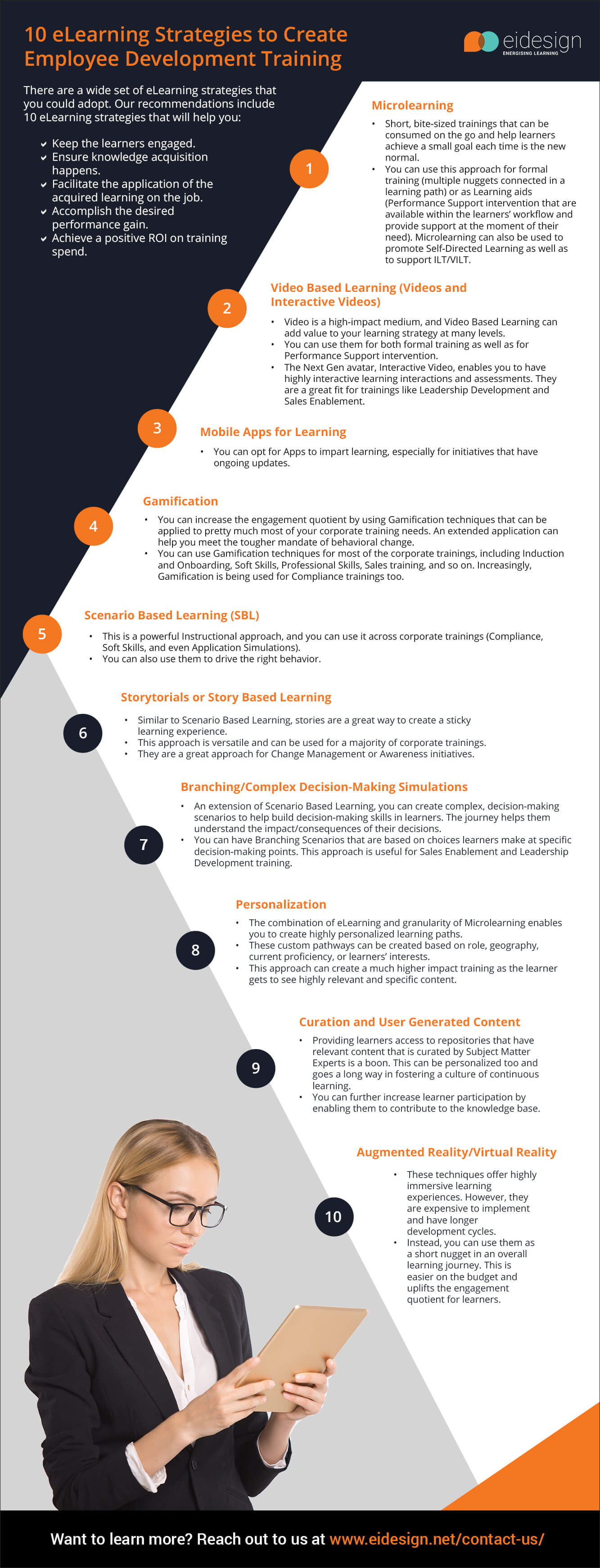My free eBook, How Can You Use Personalized eLearning to Drive Employee Performance and Achieve Higher ROI, is designed to help you understand the value in adopting Personalized eLearning.
It additionally provides insights on how it can be used to craft learning experiences that are relevant and engaging. As an extension, they provide demonstrable gains for learners and businesses, leading to a higher ROI.
How Will the eBook Help You?
eLearning and, notably, Mobile Learning are fast becoming an integral part of an organization’s training delivery.
- Learners love the flexibility it offers (training on the go and on the device of their choice). Plus, they can consume it at the pace they are comfortable with.
- Organizations see a significant gain in being able to reach a wider audience with a consistent message and track the progress effectively.
With this gain comes an associated challenge. While eLearning or Mobile Learning enables organizations to reach a wider audience. The same program gets rolled out to a heterogeneous audience that may have differences on account of:
- Learner proficiency.
- The learner’s role.
- Learning style.
Personalization of eLearning is an effective approach to address this gap. It enables you to not only reach a wider audience but design more engaging, customized and highly relevant learning experiences.
Unlike the “one size fits all” approach, Personalized eLearning provides a far more immersive and meaningful learning experience to learners.
In this eBook, How Can You Use Personalized eLearning to Drive Employee Performance and Achieve Higher ROI, I outline how you can practically adopt Personalized eLearning for your varied corporate training needs with a focus on driving the employee performance as well as a higher ROI.
Do watch my webinar on the same topic – How Can You Use Personalized eLearning to Drive Employee Performance and Achieve Higher ROI.
Loaded with examples and live demos, this webinar will provide ideas that you can use to offer Personalized eLearning for your key training needs.
Table of contents of the eBook, How Can You Use Personalized eLearning to Drive Employee Performance and Achieve Higher ROI
The eBook is divided into 4 sections, and as is the case with my other eBooks, I use a Q&A based approach.
The key questions that I address are:
- What is Personalized eLearning?
- What are the benefits of Personalized eLearning for the learners and the organization and how does it drive better performance?
- How can Personalized Learning help L&D teams in the development of employees?
- What are the learner’s needs and how can these be addressed through Personalized Learning?
- Can all trainings be mapped to a Personalized Learning based approach?
- What kind of trainings can leverage on the Personalized Learning based approach?
- What are the other measures that can enhance the impact of Personalized Learning?
- What are the techniques that you can use to offer Personalized Learning?
Here is the overview of the eBook:
Section 1: Personalized eLearning – Definition and Benefits
This section provides the definition of Personalized eLearning and lists the benefits it offers to the learners and the organizations (focusing on its ability to drive employee performance).
Section 2: How Personalized Learning Enhances the Development of Your Employees
This section provides insights on how L&D teams can leverage on Personalized eLearning to drive employee performance.
Section 3: Adopting Personalized eLearning – 6 Questions Answered
This section is designed to be a micro guide and it features 6 questions that are likely to be on your mind as you plan to adopt Personalized eLearning.
These range from the value it offers and how exactly does it help. This section also outlines the kinds of trainings that can be Personalized and other supporting measures that will help you increase their impact further.
Section 4: Techniques You Can Use to Offer Personalized eLearning
This section outlines the various techniques or approaches that you can pick from to offer Personalized eLearning for your organization.
The Value and Impact of Personalized eLearning
Learner-centric approach: We are moving towards training delivery that empowers learners and provides them the requisite control. Personalized learning is a great learner-centric technique that provides a unique and custom learning experience to each learner. It also provides them the control to select the learning path based on his or her interest, existing knowledge, or the demands of his or her role.
Impact on ROI: On account of better motivation, higher engagement, improved completion rates, and increased application of the acquired learning, the usage of Personalized learning will show a better ROI on the training spend.
This is not all. It encourages a “pull” based consumption as well as self-directed, continuous learning and you can use this to eventually trigger behavioral change too.
I hope this eBook, How Can You Use Personalized eLearning to Drive Employee Performance and Achieve Higher ROI, will provide the required insights on how you can leverage on Personalized eLearning to drive employee performance and see a better ROI on your training spend.
Do download my eBook, How Can You Use Personalized eLearning to Drive Employee Performance and Achieve Higher ROI.
If you have any specific queries or would like to see how we can help you achieve your mandate, do contact me.


